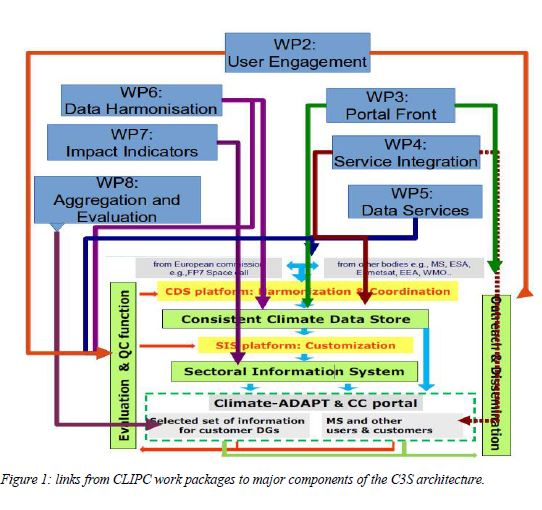D9.1 Sustainability plan
 At the end of its lifetime, CLIPC will have generated outputs in a number of areas. User requirements, software, standards, data products, including easy access to a wide variety of climateclimate
At the end of its lifetime, CLIPC will have generated outputs in a number of areas. User requirements, software, standards, data products, including easy access to a wide variety of climateclimate
Climate in a narrow sense is usually defined as the average weather, or more rigorously, as the statistical description in terms of the mean and variability of relevant quantities over a period of time ranging from months to thousands or millions of years. The classical period for averaging these variables is 30 years, as defined by the World Meteorological Organization. The relevant quantities are most often surface variables such as temperature, precipitation and wind. Climate in a wider sense is the state, including a statistical description, of the climate system. data sources, scientific analysis, an innovative impact indicator toolbox and scientific and user networks. The primary target for the CLIPC activity is the Copernicus Climate ChangeClimate Change
Climate change refers to a change in the state of the climate that can be identified (e.g., by using statistical tests) by changes in the mean and/or the variability of its properties, and that persists for an extended period, typically decades or longer. Climate change may be due to natural internal processes or external forcings such as modulations of the solar cycles, volcanic eruptions and persistent anthropogenic changes in the composition of the atmosphere or in land use. Note that the United Nations Framework Convention on Climate Change (UNFCCC), in its Article 1, defines climate change as: 'a change of climate which is attributed directly or indirectly to human activity that alters the composition of the global atmosphere and which is in addition to natural climate variability observed over comparable time periods'. The UNFCCC thus makes a distinction between climate change attributable to human activities altering the atmospheric composition, and climate variability attributa Service (C3S). As a one-stop-shop for climate information, CLIPC activities relate to many areas of the emerging C3S infrastructure, such as the Climate Data Store, the Evaluation and Quality Control function, the Sectoral Information Systems and Outreach programme. Taken together with the rapidly evolving nature of C3S, this creates challenges in identifying clear routes to sustainability. CLIPC partners have been successful in winning work in several areas of C3S. Ongoing interaction both with C3S itself and other potential users of CLIPC products, including scientific institutions and programmes and various types of stakeholders will ensure that all opportunities are exploited.
Download the deliverable here